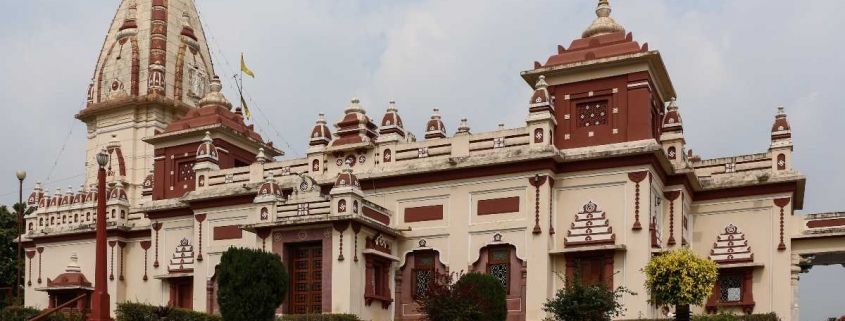Shree Lakshmi Narayan Mandir, Kurukshetra
The 12th century Shree Lakshmi Narayan Mandir was repaired in the 16th century. A Rajasthani artisan led the creation of the South Indian architecture. The entrance features a beautiful Shiva idol, followed by steps leading to Lord Lakshmi Narayan. Lord Ganesha, Lord Garuda (vahana of Lord Lakshmi Narayan) and Lord Kuber are also worshipped here. The 124-foot-high temple can be viewed from various places of the city. The temple’s original Kalash was gold, looted by Mughal Emperor Aurangzeb on his way from Delhi to Afghanistan. The Kalash presently adorning the shrine is made of brass with gold finish. A Punjabi ruler offered it. Many individuals have brought artists expecting them to build a replica or comparable temple, but they are unable to copy the present architecture.
Legend has it that the Pandavas worshipped Lord Lakshmi Narayan here before the Mahabharata war. This temple is also important in Vastu Shastra. Its east aspect allows the sun to shine on the God’s feet. Hindu priests think that yellow sacrifices to God bring financial success. To this end, hundreds of devotees come to this temple every Tuesday and Thursday.
History
Industrialist Baldeo Das Birla, together with his son Jugal Kishore Birla, were instrumental in establishing the Birla Temple in 1933. The temple’s foundation stone was laid by Jat Maharaj Udaybhanu Singh. The temple was designed by Pandit Vishwanath Shastri. The final ceremony and Yagna were conducted by Swami Keshavanandji.
They built a series of temples called Birla Temples in a number of Indian cities.
Architecture
Temple shikharas
A leader of the “Modern Indian Architecture Movement,” Sris Chandra Chatterjee designed it. The Swadeshi movement of the early twentieth century influenced the architecture and the canonical books employed. The movement did not oppose new construction concepts or technologies. In his work, Chatterjee used many modern materials.
The three-story temple is of the northern or Nagara style. The shrine is covered in carvings depicting images from the current cosmic cycle’s golden yuga. The temple’s icons were sculpted by over a hundred Benares artists guided by Acharya Vishvanath Shastri. The temple’s highest shikhara is around 49 m (160 feet) high. The temple faces east and is elevated. Fractures portraying Shastri’s life and work decorate the shrine. The temple’s icons are Jaipur marble. The temple was built of Kota stone from Makarana, Kota, Agra, and Jaisalmer. The north-facing Geeta Bhawan is dedicated to Krishna. The temple’s beauty is enhanced by a landscaped waterfall.
In the main temple are Narayan and Lakshmi. Other shrines honour Shiva, Ganesha, and Hanuman. There is also a Buddha shrine. The left temple shikhar (dome) houses Devi Durga, Shakti’s goddess. The temple measures 7.5 acres (30,000 m2) in size with a built-up area of 0.52 acres (2,100 m2).
Location
On Mandir Marg, just west of Connaught Place, you’ll find the Madir. Buses, taxis, and auto-rickshaws run regularly to the temple. R. K. Ashram Marg Metro Station is around 2 km distant. The New Delhi Kalibari is on the same road.



